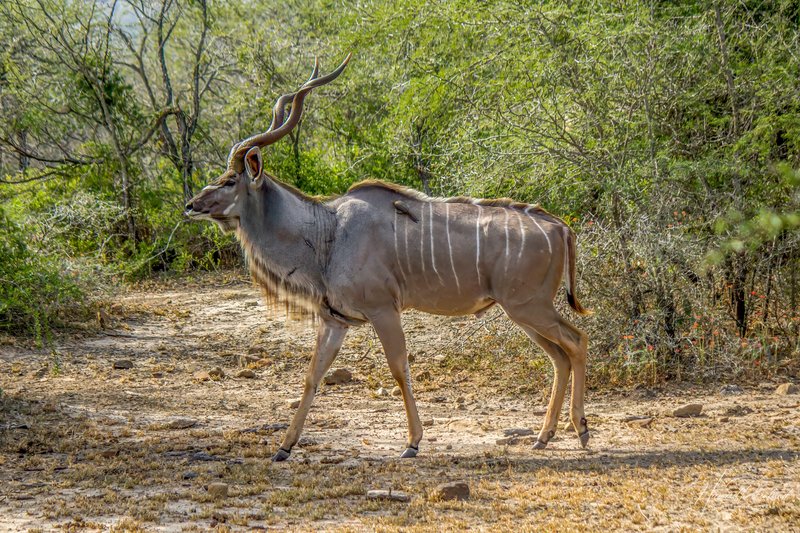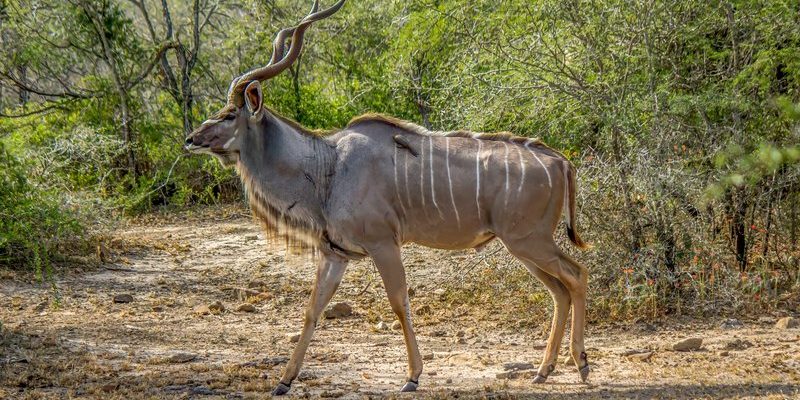
Imagine the greater kudu as a skilled chef navigating the African bush. With a keen eye for the finest ingredients, they select their meals based on what’s available in their environment. They need to be clever about foraging, dodging predators while ensuring they’re well-fed. It’s not just about eating; it’s about survival. Their diet is carefully crafted from a variety of plants, making them not just survivors but also crucial players in their ecosystem.
In this article, we’ll explore the greater kudu’s diet—what they eat and how they forage. We’ll also dive into their hunting strategies, primarily focusing on how they evade predators. By understanding these aspects, we get a clearer picture of how these beautiful creatures thrive in the wild.
The Greater Kudu’s Diet: What Do They Eat?
When it comes to food, the greater kudu is a herbivore. This means they primarily eat plants, focusing on leaves, shoots, and grasses. But their gourmet selection doesn’t stop there! They enjoy a rich variety of vegetation that keeps their diet diverse and nutritious. Here are some key elements of their diet:
- Leaves: Kudu love to munch on leaves, especially from acacia and other woody plants. Their long tongues help them reach high branches.
- Grasses: They also graze on grasses, particularly during the wetter months when grass is plentiful and fresh.
- Fruits and Flowers: Sometimes, when in season, they indulge in fruits and flowers, adding some sweetness to their meals.
The greater kudu tends to browse in the early mornings and late afternoons. This pattern helps them avoid the heat of the day, conserving energy. Plus, it’s often safer, as they’re less visible to predators during these cooler times.
You might be wondering how they find these tasty plants. The greater kudu has excellent eyesight and a keen sense of smell, which helps them identify the best foliage. They’re quite picky eaters, choosing the most nutritious options available. Their grazing habits also play a role in maintaining the health of their environment, as they help control plant growth.
Foraging and Feeding Behavior
Feeding is more than just snacking for the greater kudu; it’s a strategy for survival. Have you ever noticed how some animals seem to eat on the run? Kudu usually stand still while feeding, which helps them remain hidden. Their secret is in their body language—by being calm and discreet, they blend in with their surroundings.
Their height, which can reach up to 1.2 meters (about 4 feet) at the shoulder, gives them an advantage. It allows them to reach higher branches that many other herbivores can’t. This unique feeding behavior encourages them to select the most nutrient-rich leaves and twigs, resulting in a balanced diet that supports their health.
Another interesting aspect of their foraging is how they interact with the environment. Greater kudu are generally social creatures and can be seen in small groups. This behavior not only provides safety in numbers but also helps them collectively find food sources. If one kudu spots a good patch of leaves, the others are quick to follow, making the most of their time spent foraging.
Hunting Strategies: Staying Safe From Predators
While greater kudus are well-adapted to their diet, they also have to be mindful of those looking to make them a meal. Predators like lions and leopards are always on the hunt, so kudus have developed some fascinating strategies for evasion.
To stay safe, greater kudus rely on their incredible agility and speed. In moments of danger, they can leap up to 3 meters (about 10 feet) high and can cover distances of nearly 9 meters (about 30 feet) in a single bound. It’s like they have built-in springs! This leaping ability helps them navigate through dense brush and evade attackers.
Camouflage is another key strategy for survival. The greater kudu’s coat has a mix of browns and whites, allowing them to blend into their surroundings. When they sense danger, they often freeze in place, playing the part of an unnoticed shrub. It’s a clever tactic that allows them to go under the radar.
Beyond physical adaptations, greater kudus also rely on their social dynamics. Sticking together in small groups means they can alert each other to potential threats. One kudu might spot a predator, and the entire group can quickly react. Think of them as a well-coordinated team on a mission—they work together to stay off the menu!
Seasonal Changes in Diet and Behavior
Just like you might adjust your grocery shopping based on what’s in season, greater kudus do the same. Their diet fluctuates with the changing seasons, which impacts both their feeding behavior and habitat choices.
During the rainy season, they have access to a wider variety of soft, nutritious leaves and grasses. They thrive in these conditions, hitting peak fitness. However, as the dry season approaches, food becomes scarcer. To adapt, greater kudus often migrate to areas where there’s still greenery.
You might be wondering why this seasonal shift matters. It’s crucial for their survival! As they graze on the available vegetation, they help manage plant growth in their habitat. This behavior promotes biodiversity, supporting other animals that rely on similar food sources.
Moreover, in tougher times, greater kudus may have to change their feeding patterns. They might head into areas with tougher vegetation or riskier terrain, weighing the dangers against their hunger. Such decisions are essential for their survival.
The Importance of the Greater Kudu in the Ecosystem
Let’s take a step back and think about the greater kudu in a broader context. Their role in the ecosystem goes beyond just being an attractive antelope. By foraging and grazing, they shape their environment.
Kudus help control plant populations, which can prevent any one species from becoming too dominant. This balance is critical for other wildlife, allowing many species to thrive together. For example, smaller animals benefit from the open spaces created by their grazing, which promotes a rich biodiversity within their habitat.
Additionally, greater kudus serve as prey for many predators, contributing to the food chain. By supporting these higher predators, they help maintain the delicate balance of life in their ecosystem.
It’s comforting to realize how interconnected everything is in nature. Every creature, including the greater kudu, plays an essential role in keeping the circle of life spinning smoothly.
The greater kudu is much more than just a striking sight in the wild. Their diet and hunting strategies paint a picture of adaptability and grace in the face of challenges. From their selective foraging habits to their clever evasion tactics, these antelopes exemplify the beauty of survival.
By understanding the greater kudu, we not only appreciate their elegance but also the vital role they play in their ecosystem. They remind us of the intricate web of life in which every species has its purpose.
So next time you think of the greater kudu, picture them skillfully navigating their environment and making conscious choices for survival. It’s a beautiful dance of nature that we can all learn from!

